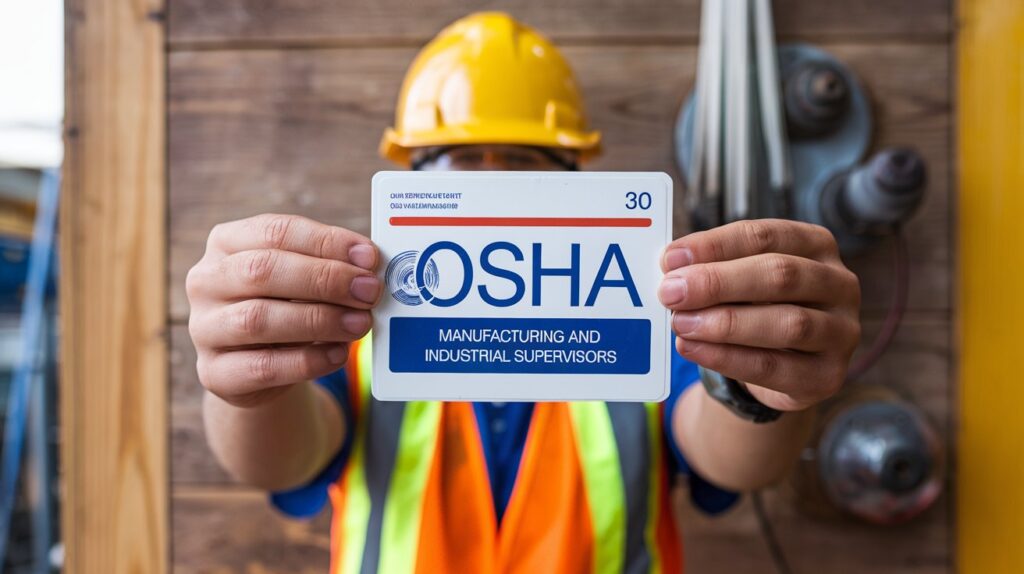Workplaces never slow down, machines keep running, teams stay busy and production targets never stop moving. In environments like this, one mistake can change everything. That’s why supervisors often look to the OSHA 30 card as more than a credential. They look at it as a way to build the skills and confidence needed to keep people safe while the work keeps moving. The U.S. Bureau of Labor Statistics reported over 2.4 million workplace injuries in the private sector in 2023, a reminder of just how critical proper training and oversight are.
This blog explores how the OSHA 30 equips supervisors to balance productivity with safety. Most importantly what this training covers and why it has become such a powerful tool for building stronger, safer workplaces.
Why Should Manufacturing Supervisors Get an OSHA 30 Card?
Supervisors are likely to spend more time with workers than anyone else in management, which puts them in the best position to prevent accidents. OSHA 30 training gives them the knowledge and strategies to step into that role effectively. Here’s why you should get an OSHA 30 as a supervisor:
Emergency Response
Factories are busy places where moving equipment, hot surfaces, and electrical systems are everywhere. When you are distracted and a simple lapse, such as a machine left running during maintenance, can quickly turn into tragedy. Supervisors with an OSHA 30 act immediately, guiding workers to safety and calling for help before situations slip out the control.
Workplace Safety Culture
Rules alone can not keep a workplace safe. It is the supervisors who maintain the safety precautions. OSHA 30 training helps supervisors to build these skills. It basically teaches them how to spot risks, address concerns, and to communicate openly. All of this results in a workplace where safety becomes as important as productivity.
Costs and Downtime Control
Workplace accidents do not just harm workers, they also delay the production. It also cost compensation claims and equipment damage. For example, an unguarded conveyor belt can hurt a worker and shut down the production line for hours. The OSHA 30 card trains supervisors to spot these risks early and prevent disruptions.
What Does OSHA 30 Training Cover for Supervisors?
OSHA 30 training covers everything from hazard recognition to advanced strategies, giving supervisors a solid base that flows into the program’s detailed topics.
Hazard Recognition and Control
With an OSHA 30, supervisors learn how to identify risks in manufacturing units and factories before they become hazardous. The training prepares supervisors to identify risks such as poor ventilation, exposed wiring, and sharp edges on unfinished materials. It then goes further by teaching practical steps to control these hazards effectively.
Machine Safety and Lockout
The majority of industrial accidents involve machinery. OSHA 30 teaches machine guarding and lockout procedures. A supervisor learns how to ensure machines are fully shut down and secured during maintenance. These measures protect workers from crushing or amputation injuries.
Emergency Planning and Response
Accidents can happen any time but a quick, informed response makes all the difference. OSHA 30 trains supervisors to act properly, such as evacuations, perform basic first aid and coordinate with emergency responders.
Prevent Common Workplace Injuries
The most common industrial injuries are slips, trips and falls. In a food processing facility, wet floors are a constant problem. Supervisors will learn to install anti-slip footwear and improve drainage by OSHA 30 training.
Encourage Open Communication
Workers sometimes keep quiet about unsafe conditions. OSHA 30 training shows supervisors how to create open communication channels. For example, discussing a recent minor injury can encourage workers to share their own concerns.
How Does the OSHA 30 Card Support Compliance?
While OSHA itself does not require supervisors to hold an OSHA 30 card, employers often use it as a compliance tool. It aligns closely with OSHA’s General Duty Clause, which requires employers to provide a workplace free of recognized hazards. Key compliance benefits
- Recordkeeping Accuracy: Supervisors trained under OSHA 30 understand reporting requirements and avoid costly violations.
- Hazard Communication: Training ensures proper labeling, SDS handling, and employee awareness.
- Emergency Preparedness: Supervisors know how to build evacuation plans, conduct fire drills, and manage crisis situations.
- Program Audits: Supervisors can assist safety managers with inspections and ensure daily tasks meet OSHA standards.
Building a Safer Future with OSHA 30 Card!
Workplace safety is not a one-time task. It requires continuous attention, leadership, and accountability. The OSHA 30 cardequips manufacturing and industrial supervisors with the skills to lead confidently, comply effectively, and inspire safer practices among their teams.
Supervisors with OSHA 30 training stand out as protectors of both people and productivity. They prevent machinery accidents, handle hazardous chemicals, or stay prepared for emergencies. So, enroll in an accredited OSHA 30 training online to create a safer workplace for your employees.

